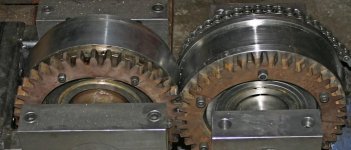snowman
Diamond
- Joined
- Jul 31, 2004
- Location
- Southeast Michigan
Has anyone ever used laminated laser cut gears? I'm curious how it may have worked out for you. Have a couple low speed relatively low torque projects where gears would be useful, but priced out of reach for traditional machined gears.
Also have a project that I'd like some 4-5" OD high torque low speed gears, but imagine that given the torque requirements, they may not be appropriate. If anyone knows of any 4-5" gears that are commonly available thus cheap that can move some serious torque, please do share!
Also have a project that I'd like some 4-5" OD high torque low speed gears, but imagine that given the torque requirements, they may not be appropriate. If anyone knows of any 4-5" gears that are commonly available thus cheap that can move some serious torque, please do share!



